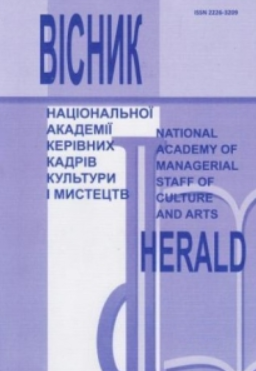ФЕНОМЕН КОРЕЙСЬКОЇ ХВИЛІ В МЕТАМОДЕРНОМУ СЕРЕДОВИЩІ ЄВРОПЕЙСЬКОЇ КУЛЬТУРИ
THE PHENOMENON OF KOREAN WAVE IN METAMODERN EUROPEAN CULTURAL ENVIRONMENT
Author(s): Larysa OsadchaSubject(s): Music, Sociology of Culture, Sociology of Art
Published by: Національна академія керівних кадрів культури і мистецтв
Keywords: Korean wave; K-pop; Hallyu; Modern epoch; Postmodernism; Metamodernism; “youthlizing” of culture;
Summary/Abstract: Purpose of the article is to analyze reasons of rapid growth of the Korean cultural product popularity in European cultural environment, to identify coincidence of the worldview, aesthetic, gaming demands of the Western consumer audience and art patterns of the Korean mass-culture. The phenomenon of the rapid popularity growth of Korean cultural products is called the “Korean wave. According to statistics, K-pop forms 2% of GDP (for comparison, Korean aviation – 0,7 %). On March 2020 the artistic heritage of the nowadays most popular Korean pop-band BTS was recognized “the strategic export product” of South Korea. That’s why it is actually to study out reasons for the great popularity of the “Korean wave” among the Western European cultural environment. Methodology. Theoretical basis of the exploration includes authors as of the applying field of cultural science, so of the fundamental one. For example, N. Tytkova (2020) analyzes style peculiarities of the Korean wave, Y. Pak (2015) outlines the genealogy of the phenomenon according to the Korean ethnic mentality specificity. Appealing to the theoretical works of R. Popty (1996) and F. Jameson (2008), T. Vermeulen and R. van der Akker (2010) has facilitated deeper understanding as of the Metamodern features of the actual European culture so the specificity of nowadays Korean pop-culture. Scientific novelty. Popularity of the Southern Korean pop-culture in Europe and Northern America is caused not only by the marketing peculiarities of the K-pop industry but also by its reasoning with key values and demands of the metamodern Western culture, such as “new sincerity”, “sober fanaticism”, “pragmatic romanticism”, “causal esotericism”. Conclusions. The powerful request for the youth artifacts and practices is been formed in the West. But artistic and academic discourse is still been under the influence of distrustfully critical postmodern narrative. Thus, the rupture between the West’s philosophical self-reflective vocabulary and applied requests for the new sincerity, and new romanticism has created favorable conditions for the youth-oriented mass-culture import.
Journal: Вісник Національної академії керівних кадрів культури і мистецтв
- Issue Year: 2021
- Issue No: 2
- Page Range: 49-56
- Page Count: 8
- Language: Ukrainian

